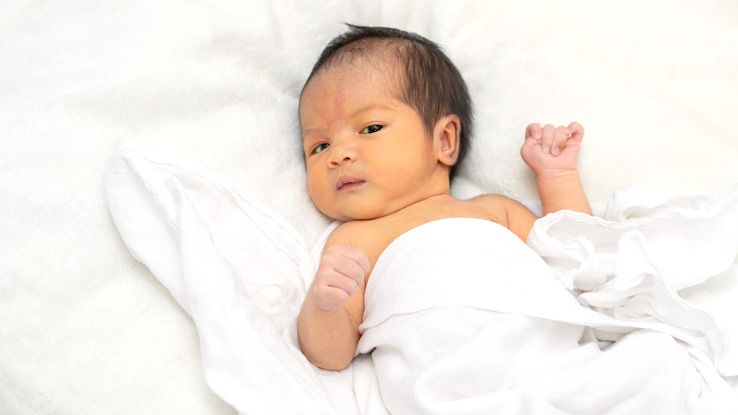What Is Jaundice? Causes, Symptoms, Treatment, and Prevention

If you look in the mirror and notice the whites of your eyes or your skin are yellow, you may have jaundice. Jaundice is caused by too much bilirubin in your blood. This chemical is always found in your bloodstream, a natural product made when the liver breaks down old red blood cells.
Usually, your liver can process bilirubin. If it can’t, bilirubin levels will increase, indicating liver malfunction or disease. This causes yellow coloring of the face, eyes, and mucous membranes. Eventually, it spreads to other areas of the body.
This article will take a deeper look at jaundice, what causes it, its symptoms, and what you can do if you think you have it.
Causes
The causes of jaundice are different for newborns and adults.
Newborns
Before a baby is born, the mother’s body takes responsibility for eliminating waste products in the baby’s bloodstream. This includes breaking down red blood cells and processing the bilirubin that results. After birth, the baby’s liver has to remove bilirubin on its own. In some babies, the liver is not developed enough to do that, so the bilirubin builds up in the bloodstream.
Adults
While jaundice is more common in newborns, it can occur at any age. Adult cases can happen in several ways:
- Jaundice can be caused by the reabsorption of a bruise or by anemic conditions in which blood cells are destroyed and removed before they should be. This can flood the body with high levels of bilirubin.
- Liver function, including bilirubin production, can be disrupted by infections, autoimmune disorders, medications, and alcohol.
- A blockage of the bile ducts can also cause jaundice by gallstones or inflammation of the gallbladder.
Risk Factors
Risk factors for babies include:
- Premature birth: These babies may not be able to process bilirubin as fast as full-term babies.
- Breastfeeding: While breastfeeding is the optimal choice for babies, if they have difficulties, they may not be getting the nutrients they need.
- Race: Babies of East Asian ancestry are more likely to develop jaundice.
- Blood type mismatch between mother and baby: The baby may have gotten antibodies from its mother that affect red blood cell breakdown.
Risk factors for adults include:
- Excess alcohol consumption.
- Use of prescription medications or other drugs that can harm the liver.
- Exposure to the viruses hepatitis A, B, or C.
- Autoimmune conditions that affect the liver.
Signs & Symptoms
The first sign of jaundice includes yellowing of the face and whites of the eyes. As the levels of bilirubin build up in the bloodstream, the yellowing can move to the chest and other body parts.
When jaundice is caused by hepatitis A, B, or C, signs, and symptoms may also include:
- Change in skin color
- Dark-colored urine or clay-colored stool
- Fever
- Chills
- Abdominal pain
If you see any of these signs or symptoms, you should seek the help of a medical professional.
Diagnosis
Aside from seeing the yellowing of the skin and eyes, doctors can perform tests to diagnose jaundice.
Bilirubin Blood Test
During the test, a doctor takes a blood sample from your arm with a needle, and the blood is collected in a tube for lab analysis. If the bilirubin amounts in your blood are too high, it may indicate that you have jaundice or that something else is causing the high bilirubin count.
Liver Function Test
A liver function test, or liver panel, checks the overall health of your liver by measuring enzymes, proteins, and other substances made by the liver. Similar to the bilirubin blood test, a doctor will take a blood sample for analysis. If the levels of any of these substances are abnormal, it may be a sign of jaundice or other liver problems.
Treatments
In babies, mild jaundice usually disappears on its own in two to three weeks. However, for more severe cases, there are treatment options:
- Proper Nutrition: More frequent feeding may be needed.
- Light Therapy (Phototherapy): The baby is placed under a special lamp that emits light in the blue-green spectrum. This changes the bilirubin molecules so they can be processed by the liver more easily.
- Intravenous immunoglobulin: If jaundice is related to blood type differences between the mother and baby, an intravenous transfusion of immunoglobulin can decrease jaundice.
- Exchange Transfusion: In rare cases, the baby may need a blood transfusion. In these cases, donor blood dilutes the bilirubin until it is at an acceptable level.
Adults usually don’t require treatment. Instead, the underlying cause may have to be treated. For example, this could include removing gallstones or treating gallbladder inflammation.
Prevention
The best way to prevent jaundice in your baby is adequate feeding. Doctors recommend 8-12 feedings a day in the first few days of life for breastfed babies. For formula-fed babies, the recommendation is 1-2 ounces every 2-3 hours for the first week.
For adults, it’s best to avoid the risk factors mentioned above.
Next Steps
You should talk to your doctor if you think you or your baby has jaundice. Your doctor can provide a thorough examination, prescribe whatever necessary tests, and advise you on the next steps to treat your condition.
Resource Links:
- “Jaundice” via Johns Hopkins Medicine
- “Adult jaundice” via Cleveland Clinic
- “Bilirubin blood test” via Medline Plus
- “Liver function tests” via Medline Plus
- “Infant jaundice” via Mayo Clinic





